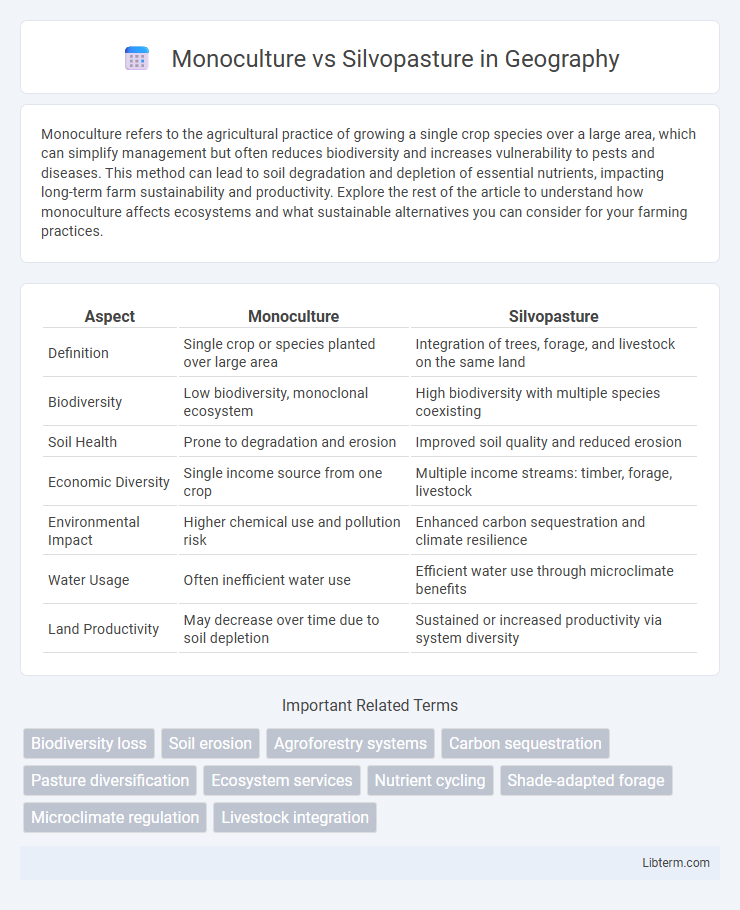Monoculture refers to the agricultural practice of growing a single crop species over a large area, which can simplify management but often reduces biodiversity and increases vulnerability to pests and diseases. This method can lead to soil degradation and depletion of essential nutrients, impacting long-term farm sustainability and productivity. Explore the rest of the article to understand how monoculture affects ecosystems and what sustainable alternatives you can consider for your farming practices.
Table of Comparison
| Aspect | Monoculture | Silvopasture |
|---|---|---|
| Definition | Single crop or species planted over large area | Integration of trees, forage, and livestock on the same land |
| Biodiversity | Low biodiversity, monoclonal ecosystem | High biodiversity with multiple species coexisting |
| Soil Health | Prone to degradation and erosion | Improved soil quality and reduced erosion |
| Economic Diversity | Single income source from one crop | Multiple income streams: timber, forage, livestock |
| Environmental Impact | Higher chemical use and pollution risk | Enhanced carbon sequestration and climate resilience |
| Water Usage | Often inefficient water use | Efficient water use through microclimate benefits |
| Land Productivity | May decrease over time due to soil depletion | Sustained or increased productivity via system diversity |
Introduction to Monoculture and Silvopasture
Monoculture is an agricultural practice where a single crop species is cultivated on a large scale, often leading to reduced biodiversity and increased vulnerability to pests and diseases. Silvopasture integrates trees, forage, and livestock on the same land, enhancing biodiversity, improving soil health, and providing diversified income sources. This agroforestry system promotes sustainable land use by combining forestry and grazing, offering ecological benefits over traditional monoculture farming.
Defining Monoculture: Characteristics and Practices
Monoculture refers to the agricultural practice of growing a single crop or raising a single livestock species over a large area, characterized by uniformity and simplicity in management. This system typically relies on high inputs of synthetic fertilizers, pesticides, and irrigation to maximize yields, often leading to soil depletion and increased vulnerability to pests and diseases. Common in large-scale farming, monoculture prioritizes short-term productivity but lacks the biodiversity and ecological balance found in alternative practices like silvopasture.
Understanding Silvopasture: Principles and Methods
Silvopasture integrates trees, forage, and livestock to create a multifunctional land system that enhances biodiversity, improves soil health, and increases farm resilience compared to monoculture. Key principles include the strategic spatial arrangement of trees to optimize light for forage growth while providing shade and shelter for animals, alongside rotational grazing to maintain pasture quality. Methods often involve selecting compatible tree species such as oaks or pines, managing understory for nutritious forage like clover, and implementing fencing systems to control livestock movement within silvopastoral zones.
Ecological Impacts of Monoculture Systems
Monoculture systems significantly reduce biodiversity by cultivating a single crop species over large areas, leading to habitat loss for many organisms and disrupting ecosystem balance. These practices deplete soil nutrients rapidly, increasing erosion and decreasing soil fertility, which intensifies the need for synthetic fertilizers and chemical pesticides. The lack of crop diversity also exacerbates vulnerability to pests and diseases, often resulting in higher ecological footprints compared to more diversified systems like silvopasture.
Biodiversity Benefits of Silvopasture
Silvopasture enhances biodiversity by integrating trees, forage, and livestock within the same ecosystem, creating diverse habitats and promoting species richness compared to monoculture systems. The presence of varied plant species supports beneficial insects, birds, and soil microorganisms, improving ecological resilience and nutrient cycles. This diversified environment reduces pest pressures and enhances ecosystem services like pollination and carbon sequestration.
Soil Health: Monoculture vs Silvopasture
Soil health in monoculture systems often declines due to repetitive planting of a single crop, leading to nutrient depletion and increased erosion. Silvopasture integrates trees, forage, and livestock, enhancing soil structure, organic matter, and biodiversity, which improves nutrient cycling and reduces erosion. This agroforestry practice promotes higher microbial activity and soil carbon sequestration compared to conventional monoculture.
Economic Considerations in Monoculture and Silvopasture
Monoculture farming often yields higher short-term economic returns due to streamlined management, specialized equipment, and focused crop production, leading to increased market efficiency. Silvopasture integrates trees, forage, and livestock, enhancing long-term profitability by diversifying income streams through timber, animal products, and improved soil health that reduces input costs. Economic risks in monoculture include market volatility and soil degradation, whereas silvopasture systems offer greater resilience and sustainability, potentially increasing land value over time.
Climate Resilience and Carbon Sequestration
Monoculture systems often reduce biodiversity, leading to lower climate resilience and limited carbon sequestration due to soil degradation and increased vulnerability to pests. Silvopasture integrates trees with pasture and livestock, enhancing carbon storage both above and below ground while improving microclimate conditions and ecosystem stability. This agroforestry practice promotes higher carbon sequestration rates and increased resilience against climate extremes compared to monoculture farming.
Challenges in Transitioning from Monoculture to Silvopasture
Transitioning from monoculture to silvopasture presents challenges such as high initial investment costs for establishing trees alongside pasture and the need for extensive knowledge in managing complex interactions between livestock, trees, and forage species. Soil fertility management becomes more intricate as farmers must balance nutrient requirements for both trees and pasture, often requiring tailored fertilization strategies. Additionally, adapting to potential reductions in short-term income due to slower tree growth and altered grazing patterns can strain economic resilience during the early years of silvopasture implementation.
Future Perspectives: Sustainable Agriculture Solutions
Silvopasture integrates trees, livestock, and forage, enhancing biodiversity and carbon sequestration compared to monoculture systems that often deplete soil health and reduce resilience. Future sustainable agriculture solutions prioritize silvopasture for its ability to improve ecosystem services, mitigate climate change, and increase farm productivity. As global pressures on food systems intensify, adopting silvopasture can optimize land use, promote sustainable livelihoods, and support long-term environmental balance.
Monoculture Infographic

 libterm.com
libterm.com